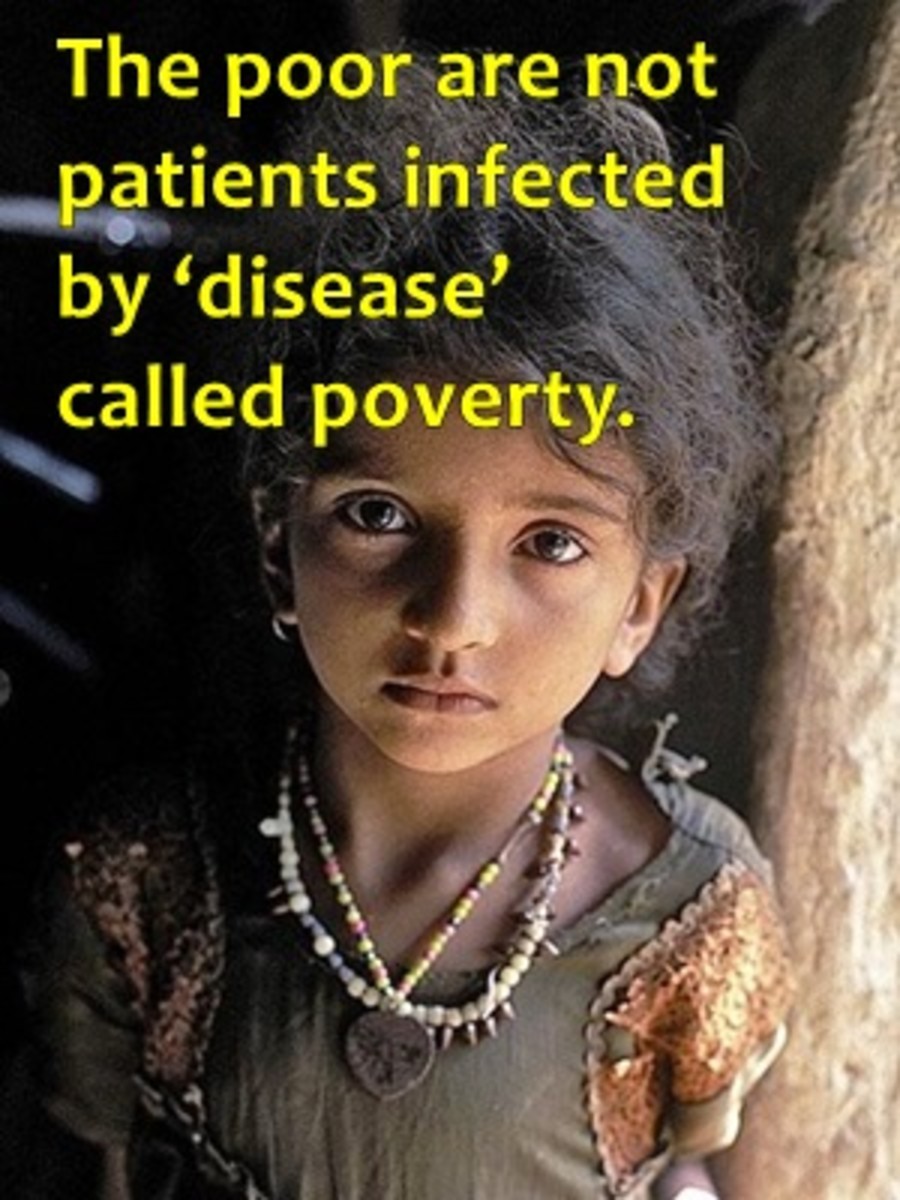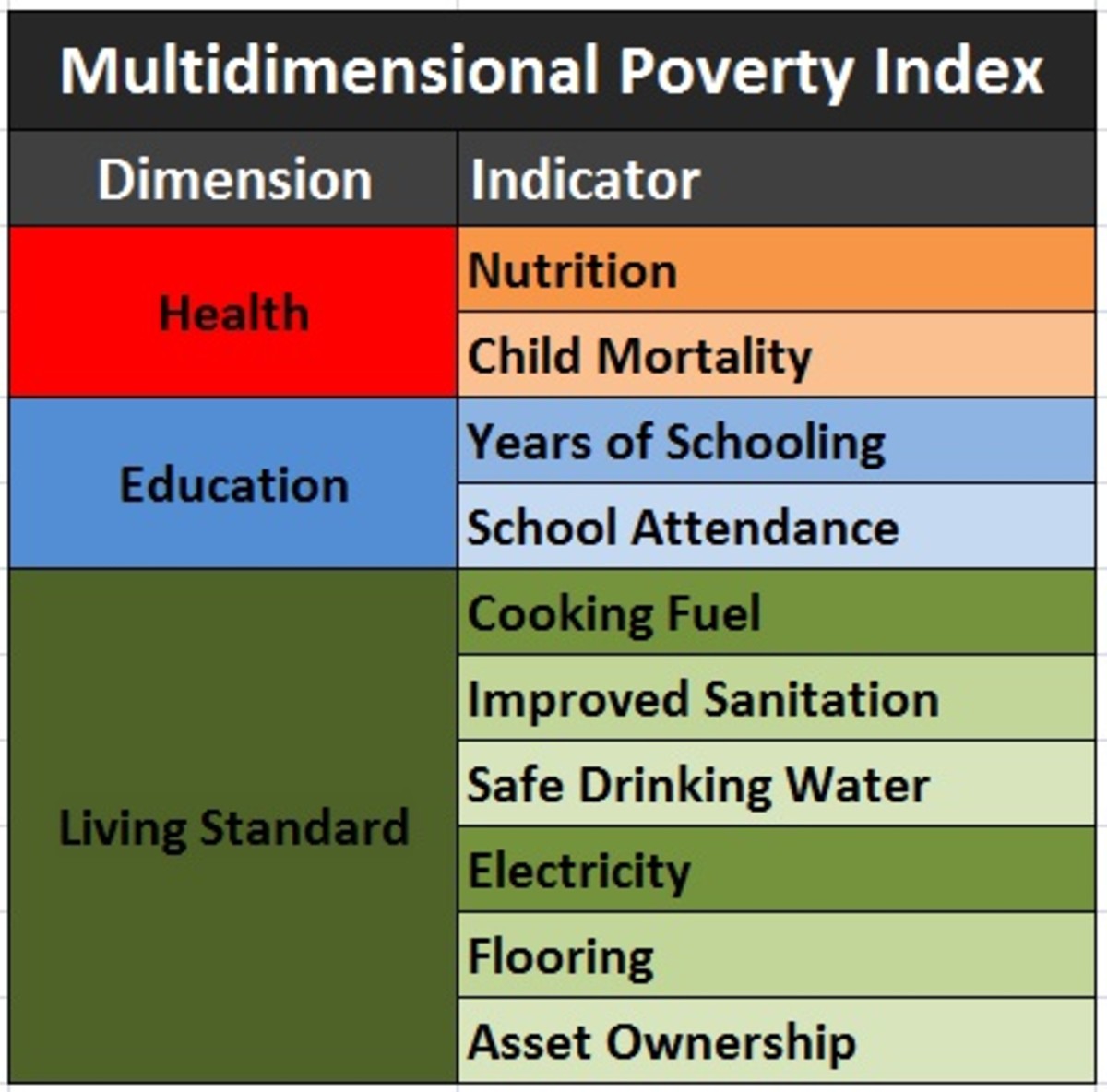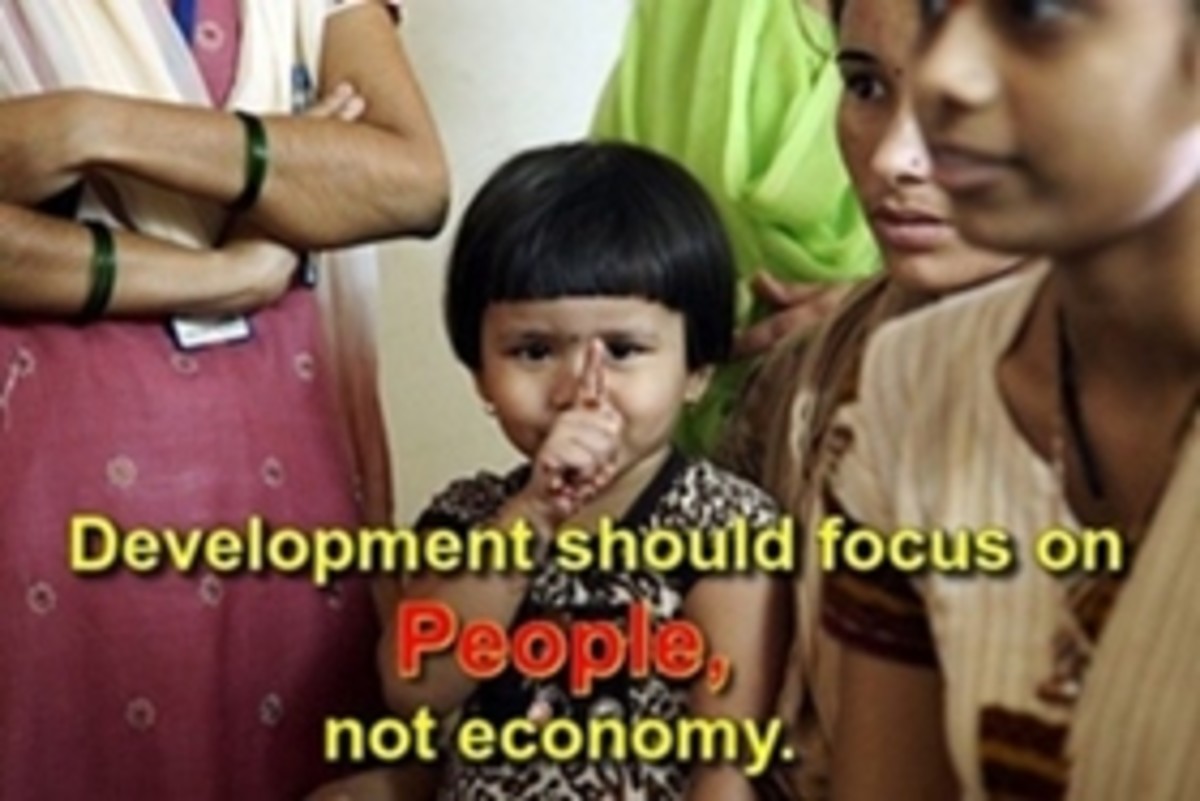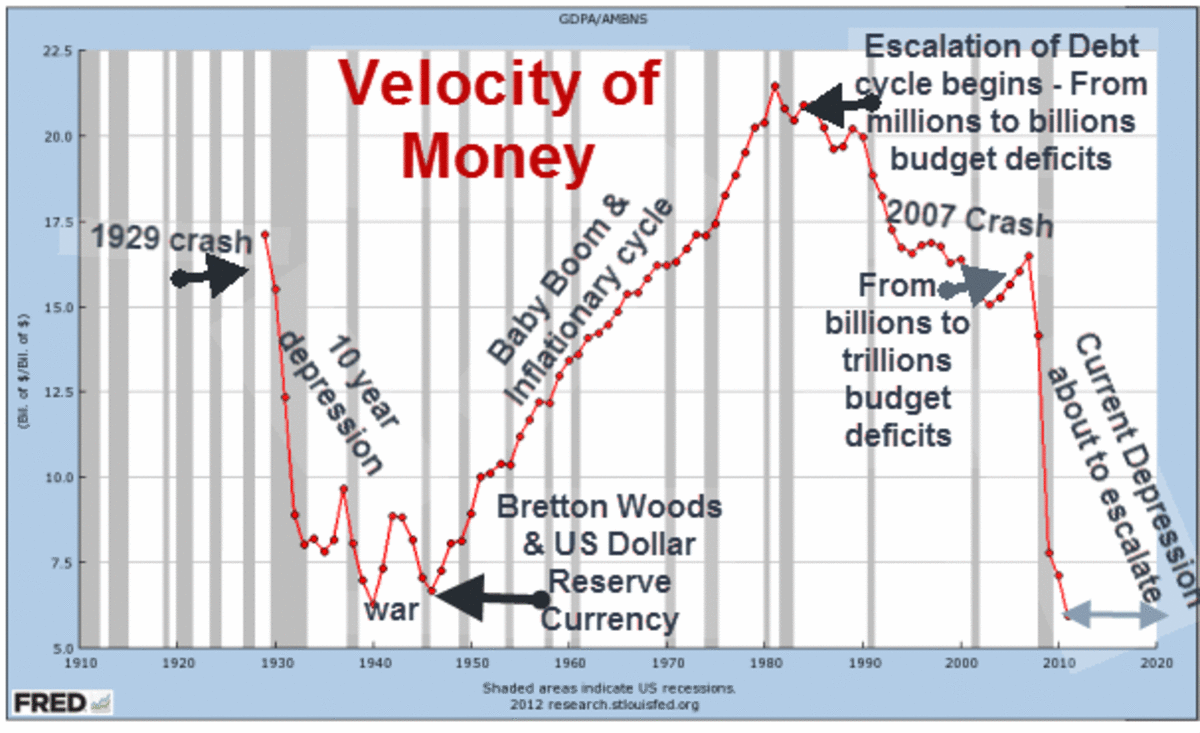Why Poverty? Let's Talk People's Development!
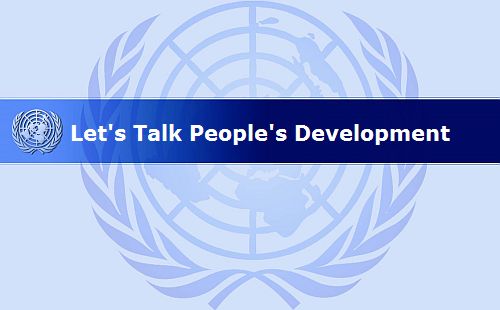
Development that perpetuates today’s inequalities is neither sustainable nor worth sustaining. - Human Development Report, 1996
What is Poverty?
Poverty is easy to spot but hard to define. The state of poverty easily gets associated with the conditions like deprivations, shortages, hardships, lack of well-being, poor quality of life, human suffering, backwardness, disempowerment, lack of development, and so on. However, poverty is traditionally seen through the monetary lens – associated with the state of having insufficient money.
Researchers converted the monetary concept of poverty into income poverty line – wherein people below a certain income threshold gets labeled as poor. For example, World Bank uses monetary poverty line of $1.90 a day to measure extreme poverty. Such one dimensional poverty line certainly simplifies the picture and helps quantification of poverty but fails to reflect the full range of hardships faced by the poor.
If, for instance, the Indian government claims that the poverty is down to around 22% it tells nothing about the state of health, education, sanitation or say, women empowerment. Moreover, two people living below the poverty line don’t face the exact same hardships or suffer in precisely the same way. The poverty line also becomes irrelevant when one considers the fact that in India, for instance, over 50% of all malnourished children come from families not under the official poverty line.
Therefore, the one dimensional poverty measure is not a good representative of poverty. Yet, most people continue to see human wellbeing, or lack of it, only in income terms. Under this perspective, the efforts for poverty elimination revolve around raising incomes through job creation. The underlying assumption is that having jobs would put them above the poverty line – – and thus cure the disease of poverty!
The basic flaw in this ‘employment’ focused remedy is that poor folks normally have low level skills, which can only enable them to get low paid jobs. So, even if employed they can’t earn enough to tackle all deprivations. With low incomes they can only live to sustain poverty, or at best, don’t sink further into deeper poverty. This may be a good situation for companies and employers to keep their labor expense low, but fails to serve the purpose of eradicating poverty.
Since poverty entails deprivation of several basic needs at the same time. A life in poverty means living deprived of sufficient food and nutrition, education, proper shelter, sanitation, clean water and so on. An ideal anti-poverty framework would try to eliminate all these shortages (and the associated incapacities). Since there are so many factors that don’t directly depend upon income, a comprehensive approach would aim to go beyond the stereotype prescription of tackling poverty through reducing unemployment.
This points to the need of seeing poverty as a multidimensional phenomenon and devising multidimensional poverty measures.
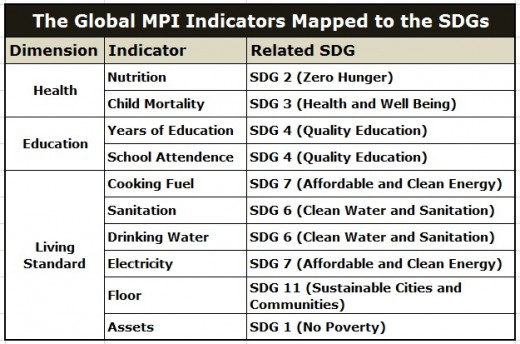
World Now Sees Poverty As A Multidimensional Phenomenon
In recent years, international bodies have started to promote and adopt this view.
The Addis Ababa Accord called on the UN and others to ‘recognize the multidimensional nature of poverty’. In December 2014, the UN Secretary General wrote, ‘Poverty measures should reflect the multidimensional nature of poverty’. In the same month, a UN General Assembly Resolution underlined the need to develop measures that better reflect the multidimensional nature of development and poverty.
The first goal of the Sustainable Development Goals (SDGs) is to end poverty in all its ‘forms and dimensions’. Discussions leading up to the SDGs highlighted the need for new poverty measures. Thus, now there is wide acceptance that poverty is multidimensional. It logically implies development of new measures to complement the monetary poverty.
Ophi’s Multidimensional Poverty Index (MPI) responds to this need and presents a new way to measure multidimensional poverty. The global MPI reflects core SDGs (see table 1 below). The methodology is quite elaborate compared with the overly simplistic monetary poverty approach and offers valuable insight on the nature and extent of deprivations people face.
Who is poor on this new measure? Any person who is deprived in at least one third of the weighted MPI indicators is identified as poor (or ‘MPI poor’).
Additionally, human well-being also depends upon non-material dimensions, which could be social, cultural, psychological, political and environmental. They are no less important than material factors. How to count or account for them?
The solution depends upon how one looks at ‘development’.
What is Development?
“People are the real wealth of nations. Indeed, the basic purpose of development is to enlarge human freedoms. People are both the beneficiaries of such development and the agents of the progress and change that bring it about.” – Human Development Report 2004 p 127
People are both the means and the end of development. It must necessarily include all factors that affect human life such as family, society, culture, politics, spirituality, and religion. People also value many things other than money such as justice, fairness, honesty, love, self-confidence, leisure time and a stress-free life.
Therefore, development is about educational facilities as much as it is about removing racial discrimination. It is about providing clean air and fighting climate change as much as it is about social and political participation. It must consider gender bias and foreign policy as much as agriculture or technological policies. Development is as much a process of providing services as of removing obstacles and giving freedom from all sorts of deprivations, discriminations and exclusions.
Seen in this context development is a multidimensional process. It brings an inescapably pluralist conception of progress. It will involve a systematic examination of a wealth of information related to people’s state of well-being.
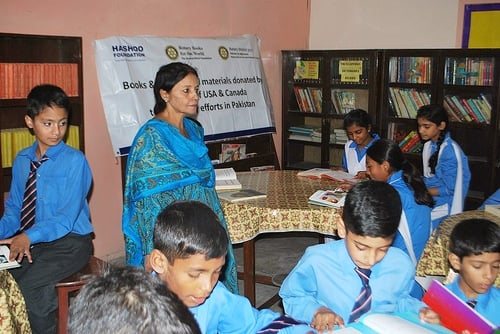
Limitations of Equating ‘Economic Growth’ with Development
In the 1980s, a development approach emerged which equated development with ‘economic growth’. It led to top-down market growth strategies and programs of privatization and deregulation. It was hoped that the economic growth led by the rich would ‘trickle down’ to the poor and poverty would be ended. This became the standard prescription of the World Bank and IMF for poor countries battling with poverty.
But experience with this experiment brought out things unacceptable to most rational thinkers. For instance, highly unequal wealth distribution and the oligarchy of the rich few controlling everything; acceptance of entrenched poverty even in rich societies and things like child labor; social exclusion of the weak and poor; neglect of the environment; increasing crimes and weakening of community fabric despite increasing wealth in the societies.
This model turned people into mere input to the economic engine and made consumption the sole yardstick of development resulting in an increasing competition for consumption of natural resources. In fact, it evolved a culture where wealth and its accumulation became the sole lifestyle.
Looking at the overwhelming negative consequences of long term nature, scholars and thinkers began questioning the monetary concept of development and poverty. Researchers started talking about ways to measure human well-being, in terms other-than income or consumption.
By now policymakers around the world have come to recognize that good human development involves inclusive economic growth, equitable distribution of income and well targeted social expenditures. It has also emerged that empowering girls and women through education and participation is perhaps the most effective social development tool.
Empowering the Poor through Micro-Credit
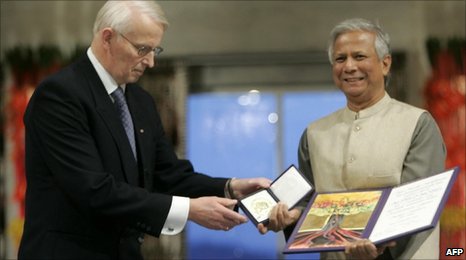
Banker of the Poorest of the Poor!
“The poor themselves can create a poverty-free world... all we have to do is to free them from the chains that we have put around them.” – Muhammad Yunus, Bangladeshi Nobel laureate of 2006 and founder of the Grameen Bank to eliminate poverty through micro-credits
Shift from Economic Development to Human Development
“The purpose of development is to enrich human lives, not richness of economy which is only a part of it.” – Amartya Sen, Nobel winner economist
The UNDP’s annual Human Development Reports (HDR) (published since 1990) considerably enriched the understanding of development from the perspective of enhancing human capabilities and freedom through the yardstick of the Human Development Index (HDI). The human development perspective is a major shift away from the traditional one dimensional economic growth (GDP) considerations of the World Bank.
The Human Development (HD) approach is founded on Amartya Sen’s capabilities theory; thus, HD model is the practical side of Sen’s theoretical ideas. In the capabilities approach, the objective of development is to expand capabilities. In the HD approach, ‘expansion of capabilities’ is simplified to ‘expansion of people’s choices.’ The language has changed; the objective has not. Look at the evolution of the definition of human development:
The HDR 1990: Human development is a process of enlarging people’s choices. The most critical ones are to lead a long and healthy life, to be educated and to enjoy a decent standard of living. Additional choices include political freedom, guaranteed human rights and self-respect.
The HDR 2010: Human development is the expansion of people’s freedoms to live long, healthy and creative lives; to advance other goals they have reason to value; and to engage actively in shaping development equitably and sustainably on a shared planet. People are both the beneficiaries and the drivers of human development, as individuals and in groups.
When countries are ranked on their HDI score, an entirely different picture of the world emerges – revealing a wide spectrum of factors, unrelated to money or consumption, that collectively enhance the wellbeing of people. These reports have had a profound impact on development policies around the world.
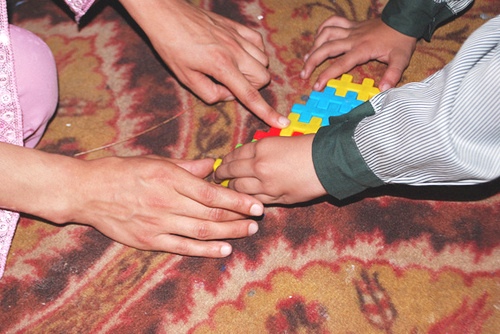
What do you think?
Global Problems and Conflicts will reduce if Development becomes People-Centric.
Moving From Income to Capabilities
When development is equated to economic (GDP) growth, people are turned into tools of economic expansion. On the one side, they become human resource for businesses to enhance their bottom-line and on the other, they are encouraged to consume more and more to increase market demand. It becomes a vicious rat race to produce more and consume more – there is no concern about environmental or social costs. All the humanness is thrown away. So what we have today is a kind of capital economy ‘without a human face’ – quoting Bill Gates.
The ‘people centric’ capabilities approach put people at the center of attention – and the kind of life they want to live or value. It approaches development from the human perspective. This integrates poverty into the wider issue of development, rather than ghettoizing it behind some arbitrary poverty line. Focus shifts from ‘poverty’ to the ‘poor’ seen as humans and their well being.
In the capability’s framework the notions of ‘well-being’ and ‘the quality of life’ are seen in terms of the capabilities. It is more concerned with people using their resources (material and non-material) to control and direct their lives.
Policies guided by the capability approach would focus on reduction in capabilities inequalities, as opposed to reduction in monetary inequalities. Money, goods and services are important means of enhancing people’s capabilities. How material possessions and facilities are converted into capabilities solely depend on individuals through factors such as age, sex, education, health, disability or even physiological factors like metabolic rate.
In order to achieve similar capabilities, people require different quantum of income or resources. For example, an elderly man would need additional resources to achieve the kind of mobility a young healthy man. He may also value medical care and rest more than the young man. The kind of life they value will also differ.
Since the focus is on individuals, issues such as gender inequality and social discrimination become more easily visible. Such differences get leveled out in the income perspective. It also recognizes that for people the “freedom to make choices about what they want to be and do with the resources available to them” is of fundamental importance.
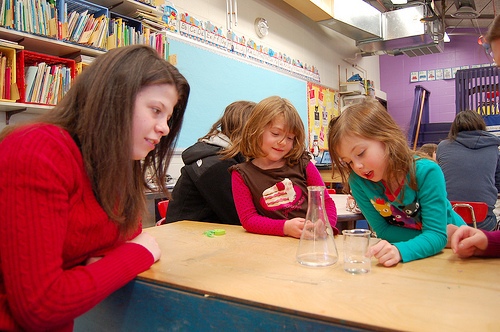
The imbalances in economic growth if allowed to continue, will produce a world gargantuan in its excesses and grotesque in its human and economic inequalities. - Human Development Report, 1996
Advantages of People Centered Development
People centered development stresses on increasing the freedoms and capabilities of people. They themselves decide what kind of life they want to live. Therefore, “freedom of choices” is an important characteristic of this approach. Since people are the focus of development their exclusion and suppression are automatically spotted, poverty doesn’t get a chance to sustain for long.
People become ‘Agents of Change’
People become ‘Agents of Change’, rather than passive targets of expert created development programs. In the development process “people have to be seen as being actively involved and given the opportunity – in shaping their own destiny.” So the central theme of development becomes empowerment of people to become agents of change in their own lives. Once recognized as agents people (individually or in groups) can define their goals and select suitable means to achieve them.
Additionally, once people fit in the role of “agents of change” they can themselves build the environment in which they are empowered with education, health, ability to speak freely and participate, etc. That’s the path of sustainable development.
Poverty is Seen as Deprivation of Basic Capabilities
Poverty must be seen as the deprivation of basic capabilities rather than merely the lowness of incomes. – Amartya Sen, Nobel Prize Winner, 1998
In Development as Freedom (1999), Amartya Sen defines poverty as a situation that severely decreases a person’s capabilities. Thus, an individual is poor if he lacks basic capabilities. Well-being of people ultimately depends upon what they can or cannot do. Thus, the standard of living enjoyed by people must be seen in terms of people’s capabilities – and not in terms of income and material possessions.
In simple terms, poverty is a state of denial of freedom, choices and opportunities for living a tolerable life.
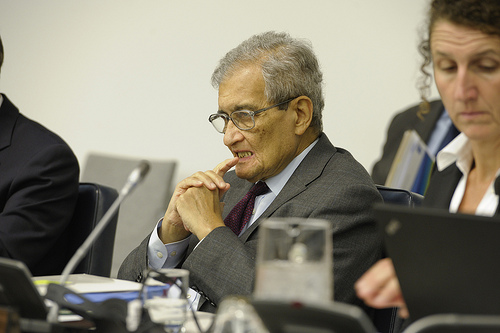
Moving From Income to Capabilities
Money, goods and services are important means of enhancing people’s capabilities. How material possessions and facilities are converted into capabilities depend on individuals through factors such as age, sex, education, health, disability or even physiological factors like metabolic rate. People can’t be equalized in terms of income or resource because their requirements differ in order to achieve similar capabilities. For example, an elderly man would need additional resources to achieve the kind of mobility a young healthy man. He may also value medical care and rest more than the young man. The kind of life they value will also differ.
Since the focus is on individuals, issues such as gender inequality become more easily visible. Such differences get levelled out in the income perspective. It also recognizes that for people the “freedom to make choices about what they want to be and do with the resources available to them” is of fundamental importance.
It can be seen that the capability theory approaches life from a positive perspective – the kind of life we want to live or value. This integrates poverty into the wider issue of development, rather than ghettoizing it behind some arbitrary poverty line. This is reflected in the ideas of ‘human development’ and ‘well-being’ of the Human Development Reports of the UNDP. In the capability’s framework the notions of ‘well-being’ and ‘the quality of life’ are seen in terms of the capabilities. It is more concerned with people using their resources (material and non-material) to control and direct their lives.
Policies guided by the capability approach would ‘require a change in public policy focus from the reduction of monetary inequalities to reduction in capabilities inequalities. However, it must be kept in mind that the capabilities are not created in isolation, but are shaped by social structure and institutions.
Advantages of People Centered Development
People centred development stresses on increasing the freedoms, abilities and capabilities of people. They themselves decide what kind of life they want to live. It is different from the top-down development model where an outside development agency tells people what to do. Therefore, “freedom of choices” is an important characteristic of this approach. Since people are the focus of development their exclusion and suppression are automatically spotted, poverty doesn’t get a chance to sustain for long.
People become “Agents” of Change
Amartya Sen and also Muhammad Yunus see people as “Agents” of Change, rather than passive beneficiaries of expert created policies. In the development process “people have to be seen … as being actively involved – given the opportunity – in shaping their own destiny, and not just as passive targets of development programs.” So the central theme of development should be to empower people to become agents of change in their own lives. Once recognized as agents people (individually or in groups) can define their goals and select suitable means to achieve them.
Additionally, once people fit in the role of “agents of change” they can themselves build the environment in which they are empowered with education, health, ability to speak freely and participate, etc. That’s the path of sustainable development.
Conclusion
Presence of poverty indicates lack of people development through denial of freedom, choices and opportunities. It is a situation of very low human well being. It is not an income issue, but a human development problem. It is more an empowerment or capacity building problem. Once empowered, the poor can become ‘agents of change’ in their own lives and cease to be poor. The process of development should invariably include everything that enhances people’s capabilities.


